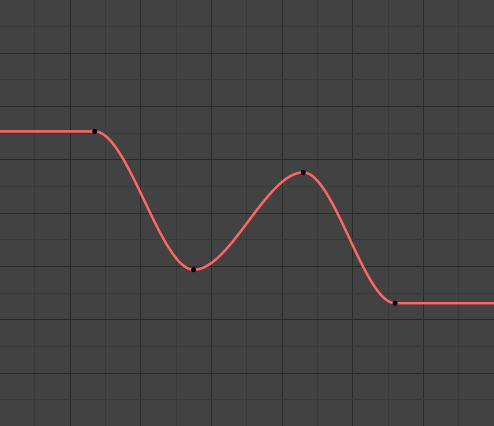Editing(編集)
Delete Channels(チャンネルを削除)
参照
- Menu(メニュー):
- ショートカットキー:
X
Deletes the whole channel from the current action (i.e. unlink the underlying F-Curve data-block from this action data-block).
警告
ショートカット X はエリアに依存します: 左側のリスト部分で使用すると、選択したチャンネルが削除されますが、メインエリアで使用すると、選択したキーフレームが削除されます。
Un/Group Channels(グループチャンネル/チャンネルをグループ解除)
参照
- Menu(メニュー):
- ショートカットキー:
Ctrl-Alt-G 、 Ctrl-G
グループ名をダブルクリックして名前を変更できるコレクションに選択したチャネルをグループ化/グループ解除します。例えば、これは、アーマチュアの一部に関連するチャネルをグループ化して、エディターをより整理された状態に保つのに役立ちます。
Toggle/Enable/Disable Channel Settings(チャンネル設定の切替/有効化/無効化)
参照
- Menu(メニュー):
- ショートカットキー:
Shift-W 、 Shift-Ctrl-W 、 Alt-W
チャネルの設定を有効/無効にします(ポップアップするメニューで選択します)。
- Protect(保護)、 Mute(無効化)
(未稿)。
Toggle Channel Editability(チャンネルの編集可否を切替え)
参照
- Menu(メニュー):
- ショートカットキー:
Tab
編集のためにチャンネルをロックまたはロック解除します。
Extrapolation Mode(外挿モード)
参照
- Menu(メニュー):
- ショートカットキー:
Shift-E
選択したキーフレーム間の外挿を変更します。
外挿は、最初のキーフレームの前と、最後のキーフレームの後の曲線の動作を定義します。
2つの基本的な外挿モードがあります:
- Constant(一定):

一定の外挿。
デフォルトのカーブは、最初のキーフレームの前と最後のキーフレームの後に一定の値(最初と最後のキーフレームの値)を持ちます。
- Linear(リニア):

リニアな外挿。
曲線の端は、最初と最後のキーフレームの傾きによって定義される直線(リニア)です。
その他の外挿法(例: Cycles モディファイアー)は、 F-Curve Modifiers(Fカーブモディファイアー) にあります。
Add F-Curve Modifier(Fカーブモディファイアーを追加)
参照
- Menu(メニュー):
- ショートカットキー:
Shift-Ctrl-M
Opens a pop-up allowing you to add modifiers to the active F-Curve. Settings for the modifier can be found in the tab.
Show/Hide(表示/隠す)
- Hide Selected Curves(選択中のカーブを隠す) H
選択中のカーブを隠します。
- Hide Unselected(非選択物を隠す) Shift-H
選択したカーブのみを表示します(他のすべてを非表示にします)。
- Reveal Curves(カーブを再表示) Alt-H
非表示にしているすべてのカーブを表示します。
Expand/Collapse Channels(チャンネルを展開/折りたたむ)
参照
- Menu(メニュー):
- ショートカットキー:
NumpadPlus, NumpadMinus
選択したチャンネルを展開・折りたたみます。
Move(移動)
参照
- Menu(メニュー):
選択したチャンネルを:kbd:PageUp 、 PageDown で上下に移動し、 Shift-PageUp 、 Shift-PageDown で直接最上段/最下段へ移動します。
Revive Disabled F-Curves(無効な F カーブを復活)
参照
- Menu(メニュー):
Clears "disabled" tag from all F-Curves to get broken F-Curves working again.
Frame Selected Channels
参照
- Menu(メニュー):
- ショートカットキー:
NumpadPeriod
Reset viewable area to show the selected channels. To frame the channel that is under the mouse cursor, use Alt-MMB.
- Include Handles
Include handles of keyframes when calculating extents.
- Use Preview Range
Ignore frames outside of the preview range.
Keys to Samples
参照
- Menu(メニュー):
- ショートカットキー:
Alt-C
This operator replaces an F-Curve with a set of sampled points at each full frame. It is a destructive process that removes the ability to edit the curve. The main use for this is to reduce the file size with large datasets. Samples are only 1/5th the size per key. The sampled points interpolate linearly on subframes.
Samples to Keys
参照
- Menu(メニュー):
This operator replaces a sampled F-Curve with keyframes, adding the ability to edit it. It will not recreate the curve as it was before, instead it will place 1 key at every frame.
Sound to Samples
参照
- Menu(メニュー):
The Sound to Samples operator takes a sound file and uses its sound wave to create the animation data. By default this data will not be editable, use Samples to Keys to get editable keyframes.
- Lowest Frequency(最低周波数)
音声データに適用されるハイパスフィルターのカットオフ周波数。
- Highest Frequency(最高周波数)
音声データに適用されるローパスフィルターのカットオフ周波数。
- Attack Time(アタック時間)
ハルカーブが上昇する早さを示す値です。小さな値で早く上昇します。
- Release Time(リリース時間)
ハルカーブが下降する早さを示す値です。小さな値で早く下降します。
- Threshold(しきい値)
ハルカーブに影響を与えるのに必要な最小振幅値です。
- Accumulate(蓄積)
出力を生成するのに、ハルカーブ振幅の正の差異のみが集約されます。
- Additive(付加)
ハルカーブ振幅が集約されます。 Accumulate(蓄積) がONの時、正と負の差異の両方が蓄積されます。
- Square(正方形)
出力が矩形カーブになります。負の値が常に-1に、正の値が1になります。
- Square Threshold(矩形のしきい値)
このしきい値より低い値はすべて0になります。
Discontinuity (Euler) Filter(不連続(オイラー)フィルター)
参照
- Menu(メニュー):
(未稿)。